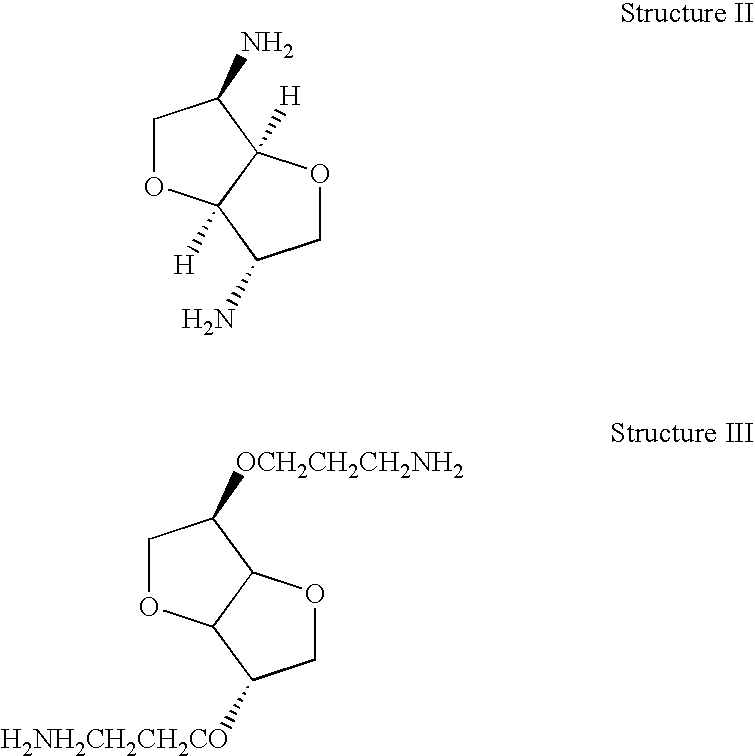Thermoset epoxy polymers from renewable resources
a technology of epoxy polymer and renewable resources, applied in the field of thermoset epoxy polymers, can solve the problems of polymer may slowly decay and the structure is not completely stabl
- Summary
- Abstract
- Description
- Claims
- Application Information
AI Technical Summary
Benefits of technology
Problems solved by technology
Method used
Image
Examples
example 1
Preparation of Isosorbide Diglycidyl Ether using Aqueous Alkali
[0022]Into a 1000 ml three-neck flask fitted with a Dean-Stark tube, condenser with exit bubbler tube, pressure-equalizing dropping funnel, gas inlet and sealed paddle stirrer were placed 29.2 g (0.20 moles) isosorbide, 200 ml dimethyl acetamide (DMAC) and 200 ml toluene. A slow stream of argon was passed through the apparatus to prevent oxidation. A solution of 16 g sodium hydroxide (0.40 moles) in 16 ml water was added drop-wise to the flask and the mixture stirred briskly and refluxed for 4 hours as water collected in the Dean-Stark tube. A total of 28 ml water was collected (the theoretical yield is 16 ml+7.2 ml=23.2 ml). Approximately 100 ml toluene was allowed to distil out from the system and 100 ml DMAC added. The hot mixture was left to cool somewhat and 1.0 ml 15-crown-5 ether added.
[0023]The Dean-Stark tube was replaced with a plain reflux condenser and 39 g (0.50 moles) epichlorohydrin added drop-wise to the ...
example 2
Preparation of Isosorbide Diglycidyl Ether in a Non-Aqueous Solvent
[0024]Seven grams of isosorbide were dehydrated by refluxing under a Dean-Stark tube with toluene for two hours. The solvent was evaporated to dryness in a rotary evaporator. To 5.82 g (0.04 moles) freshly dried isosorbide was added 100 ml anhydrous dimethyl sulfoxide under anhydrous conditions and argon blanket and stirred and warmed to 50° C. It dissolved to give a clear pale brown solution. Sodium hydride dispersion in oil (equivalent to 0.08 moles) was weighed out quickly and added to the solution in which it dissolved rapidly with effervescence evolving hydrogen. After one hour no more gas was evolved and a precipitate separated out, presumably the insoluble sodium alkoxide. The mixture was stirred at 25° C. for 48 hrs, then 0.12 moles epichlorohydrin added and the mixture stirred under argon for another 48 hours at 25° C.
[0025]The mixture as added to 500 ml water and stirred for two hours, the final pH was 8.0....
example 3
Isosorbide Diglycidyl Ether Using a Cationic (Lewis Acid) Route
[0026]A three neck 500 ml flask fitted with a paddle stirrer, reflux condenser and a dropping funnel, was charged with 73 g (0.50 moles) solid isosorbide and heated in an oil bath under an argon atmosphere to 100° C. The solid melted to a colorless oil and the melt was stirred while stannous fluoride (1.6 g, 0.01 mole) catalyst was added and then 78 ml (1.0 moles) epichlorhydrin added drop-wise from the tap funnel. Initially the mixture went milky, but as the bath was raised to 130° C. and the epichlorhydrin began to reflux (bp 115-120° C.), the mixture went to a pale straw-colored homogeneous liquid. It was held at 130-135° C. for several hours and the color slowly went to a mid straw. The refluxing slowly ceased as the epichlorhydrin all reacted.
[0027]After cooling overnight, the mixture was diluted with 150 ml toluene and a solution of 40 g (1.0 mole) sodium hydroxide in 40 ml water was added drop-wise with brisk stir...
PUM
| Property | Measurement | Unit |
|---|---|---|
| temperatures | aaaaa | aaaaa |
| temperature | aaaaa | aaaaa |
| molecular weight | aaaaa | aaaaa |
Abstract
Description
Claims
Application Information
 Login to View More
Login to View More - R&D
- Intellectual Property
- Life Sciences
- Materials
- Tech Scout
- Unparalleled Data Quality
- Higher Quality Content
- 60% Fewer Hallucinations
Browse by: Latest US Patents, China's latest patents, Technical Efficacy Thesaurus, Application Domain, Technology Topic, Popular Technical Reports.
© 2025 PatSnap. All rights reserved.Legal|Privacy policy|Modern Slavery Act Transparency Statement|Sitemap|About US| Contact US: help@patsnap.com


